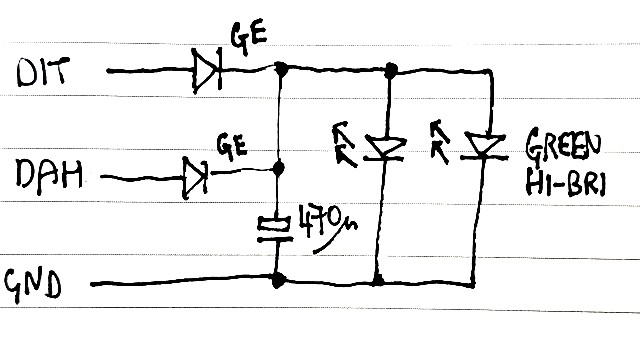Pimping up a Palm Radio mini paddle - by Hans G0UPL
Fun with a QMX+ and a Palm Radio mini-paddle special edition (green). I modified the paddle to include two high brightness 3mm green LEDs in the very small recess in the base of the unit; and modified the QMX+ to supply current via the paddle connections.
Modifications to QMX+
I added a 91-ohm resistor from the "Tip" (KEY_DAH) connection of JP211, to a Vdd connection (the mid pin of JP106. There's nothing special about 91-ohms it was just the first resistor of an approximately feel-good value which fell into my fingers as I rummaged through the box. 100, 82, would be fine too... and maybe even wilder deviations. As long as the paddle contact isn't closed, current will be supplied from the 3.3V rail via this resistor. The resistor doesn't affect the function because the GPIO pin is read as active-low, and already has an enabled weak internal pullup resistor in the microcontroller.
The "Ring" connection (KEY_DIT) already has a 2.2K pullup resistor to +3.3V which will supply the electret microphone when the SSB firmware is ready; I didn't want to meddle with this so I left it at 2.2K as it is.
Modifications to the Palm Radio mini paddle
Now to actually pimp up the paddle. A very well engineered high quality paddle, and I wanted to avoid too much mutilation if possible. This is the implemented schematic:

In principle - current supplied by either the Dit or Dah wire charges up the 470uF capacitor via one of the two diodes. The two green LED's are high brightness types (actually stolen from the 50W QCX Amplifier kit). They appear to be identical enough that they don't mind being connected in parallel.
The point is that when either the Dit or Dah paddles are closed, that signal will be shorted by the paddle, to ground. Therefore it will stop supplying current to the LEDs. Inevitably the LED's therefore switch off when the paddle is closed. However this effect is mitigated by the fact that current can be supplied either by the Dah wire (91-ohms to 3.3V) or the Dit (2.2K to 3.3V). The two diodes happen to be old junkbox Germanium; Schottky diodes would be fine also. Even humbles 1N4148 work but the LEDs are less bright; this is why Germanium or Schottky are best, the voltage drop across the diode is about 1/2 to 1/3 that of a silicon diode (as little as 0.2V instead of approx 0.6V).
I put the 470uF capacitor in so that at least there would be some energy storage; the extinguishing of the LED would therefore be more gentle. Which is both visually more pleasing, and also perhaps avoiding sudden current consumption changes would avoid inflicting any unwanted artifacts such as audible clicks, during keying. The 470uF capacitor is a tantalum stolen from a QMX SMPS board, chosen for its small volume.
Construction: I used a piece of solid copper wire in a ring, as a ground; it was carefully sized to fit in the tiny recess under the mini-paddle, a tight fit that has to be eased in with pressure from a screwdriver. There is only space for the 3mm LED's lying down. The Germanium diodes barely fit, too - there is a central round protrusion which slots into a hole in the key cover, to hold it in place when the key is retracted vs in operating mode. So I had to work around that circular protrusion too. For each of the connections to the dit and dah, I was able to solder on 0.3mm wire (the same wire as used in many QRP Labs kits) and fit it into the hole in the paddle structure, and actually solder it to the tiny gold-plated PCBs that make up the paddles. The ground connection was more difficult and I had to carefully cut off a piece of the insulated wire near the 3-pin socket on the mini-paddle, and solder the ground wire to that. So - fairly minimal modifications to the mini paddle.
In operation
In operation there is no impact on the normal operation of the QMX+ keying. The current consumption of the QMX+ at 12V supply appears to increase by approximately 4mA according to the current metering on my bench power supply.
Here's a short YouTube video showing how it all looks in operation. https://www.youtube.com/watch?v=uF2v3DBiw94
Well - you can imagine maybe some day I might have a solar panel and batteries powering my station, and some day there could be a power outage, and it might even happen that some day I have enough time to get back to my early morning pre-dawn winter 40m CW practice hour, and you know, in those circumstances at least I'd be able to find the key on my messy workbench. And meanwhile: It's just a cool thing :-)

